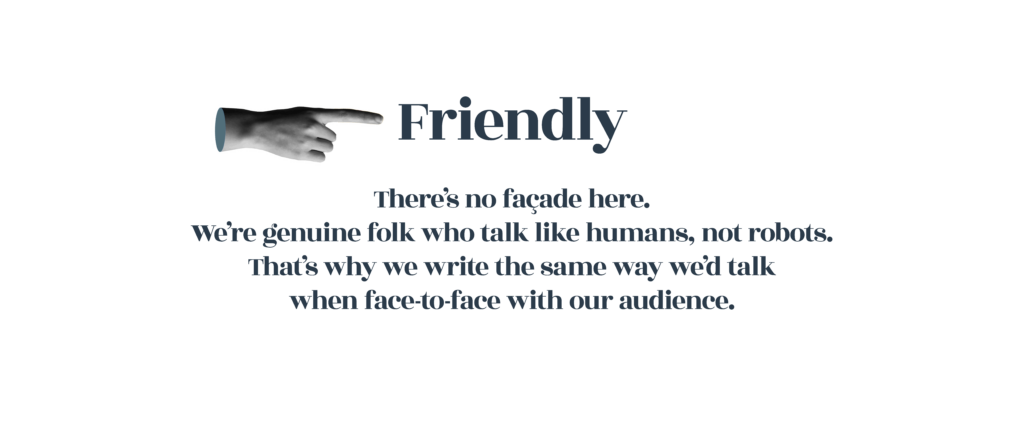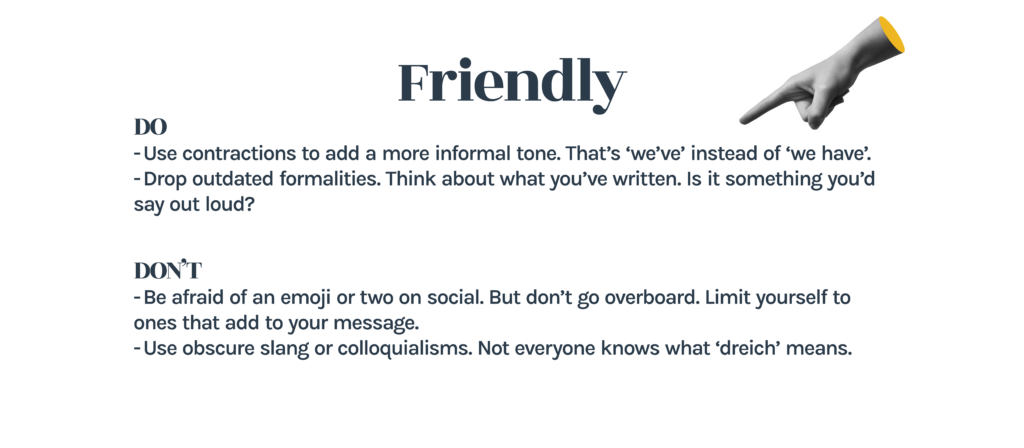Your guide to tone of voice – creating guidelines worth reading
Kendra Bodles • 8th Jul 2024

When it comes to brand guidelines, logo rules, colours and fonts are a constant presence, and often a thing of beauty. On the other hand, tone of voice regularly gets relegated to just a page (or two if you’re lucky).
The visual stuff rightly gets the limelight it deserves but given its tonal brand buddy is an equally major touchpoint, top level just isn’t going to cut it.
What’s a tone of voice guide?
There are loads of different ways to write, unique styles, and no clear cut yes and no when it comes to tone. That makes it very easily open to interpretation – the nemesis of consistency.
That’s where a tone of voice guide comes in. It identifies the distinct way a brand expresses itself and how that can be replicated across communications. Whether you’re writing internally or externally on behalf of a brand, it shapes not just what you say, but more importantly how you say it.
And the best ones are instantly recognisable.
Why do I need one?
A well thought through and presented tone of voice guide will help your brand make the right impression and manage consistency, especially when you have numerous people writing for you.
Copywriters wear many masks as they jump from brand to brand, and a clear tone of voice guide will help them get into character. It does the hard work, so that they don’t have to. That means less of their time spent getting to grips with your brand and more time focused on the task you’re actually paying them to do.
That’s why it deserves a proper feature within any brand guidelines.
What do writers like to see?
Tone of voice guidelines should be a tool that can answer questions, not create more of them. Filling it with the right stuff from the off will save you time down the line.
Of course, it will ultimately depend on who you’re talking to, where you’re talking to them and how complex your subject matter is. But in general, the following things will get you off to a flying start – they’re the key to keeping your writers happy and your team on brand.
Pillars
These are the bare necessities, and like any good pillar, provide the firm support for everything that follows.
How many is up to you and your needs, but we find 4 is the magic number – enough to cover everything, be memorable and remain complexity-free.

For pillar success, each must be supported by your internal team, stem from your brand values and personality traits and most importantly be crystal clear. To get that clarity, think conversational instead of natural, polished instead of sleek. Use words that need as little explanation as possible.
And to help sell each pillar in, pair them with a brief insight on why they’ve been chosen, making sure it’s in the very tone you’re trying to promote.

Dos and don’ts
Next, it’s all about nailing the actual mechanics of each pillar and how they will work in practice.
Some simple dos and don’ts are a quick way to cover off major copy characteristics and practices, making sure everyone’s on the same page. You could create a few per pillar or have one central list.

Before and afters
These are particularly helpful if you’ve had a brand update and are worried that people may revert to the way things have always been done. Examples always help with understanding – show, don’t tell whenever you can.

Key messages
And the examples keep coming. By pairing your tone with some key messages, you can take the two-birds-one-stone approach to cover off what you’re saying and how you’re saying it.
You could stick to your shortlist of messages and provide some general headlines and lines. Or, even better, show how they work in reality with example social captions, and visuals that also incorporate the brand identity.
Style guide
This is all about dotting the Is and crossing the Ts.
Not a necessity for everyone, this optional extra is more for brands that have complex content needs and specific standards for terminology. It will focus on the things that dos and don’ts might not cover like formatting rules and branded terms, helping you maintain a tighter grip on external-facing assets and the people writing them.
Tone of voice is not a nice-to have
It’s an essential, no matter your business size or sector. And the best examples get their feature within the overall brand guidelines so that everyone has a clear and central brand truth.
The beauty also comes from nailing that sweet balance of instruction and simplicity. You want to give enough information to build understanding without boring everyone.
How you present your guide can help a lot with this. Zhuzh it up with a bit of your visual brand flavour and people are more likely to engage, learn and follow.
Copy that?
If you’re after some copy crafting or want to find your true brand tone, we can help.


